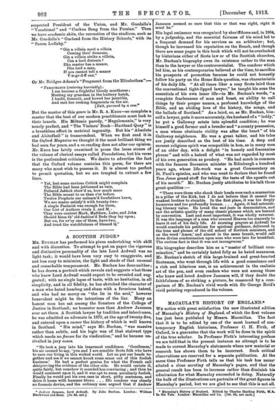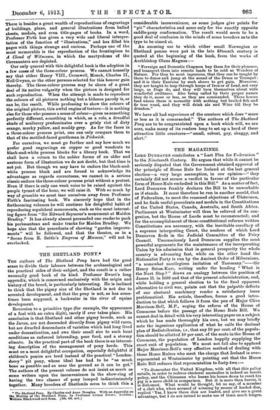MACAULAY'S HISTORY OF ENGLAND.*
WE notice with great satisfaction the new illustrated edition of Macaulay's History of _England, of which the first volume has just been published by Messrs. Macmillan. The fact that it is to be edited by one of the most learned of con- temporary English historians, Professor C. H. Firth, of Oxford, is a guarantee that the work will be done in the spirit of the true scholar. In Professor Firth's interesting preface we are told that in the present instance no attempt is to be made to correct Macaulay's statements where new material or research has shown them to be incorrect. Such critical observations are reserved for a separate publication. At the same time Professor Firth tells us that his task has neces- sitated a close scrutiny of Macaulay's pages, and that the general result has been to increase rather than diminish his admiration for what Macaulay succeeded in doing. Naturally the bulk of the illustrations are portraits of the great figures in Macaulay's period, but we are glad to see that this is not all.
• Macaulay's History of England. Edited by Charles Harding Firth, M.A. In Six Vols. London: Macmillan and Co. [10s. 6d, net each.]
There is besides a great wealth of reproductions of engravings of buildings, plans, and general illustrations from ballad sheets, medals, and even title-pages of books. In a word, Professor Firth has given a very wide and liberal interpre- tation of the function of "illustrations," and has filled his pages with things strange and curious. Perhaps one of the most memorable is the reproduction of the frontispiece to A Cloud of Witnesses, in which the martyrdoms of the Covenanters are depicted.
Our only quarrel with this delightful book is the adoption in a few cases of the three-colour process. We cannot honestly say that either Henry VIII., Cromwell, Monck, Charles II., Nell Gwynn, or the other persons selected for this honour gain thereby. The three-colour process may be shorn of a great deal of its native vulgarity when the picture is designed for such reproduction. When the attempt is made to reproduce the colours of oil pictures nothing but a hideous parody is, or can be, the result. While professing to show the colours of the original picture, this awful engine of torture—it is nothing else for those who possess a sense of colour—gives us something perfectly different, something in which, as a rule, a dreadful shade of mulberry predominates over a grisly riot of dirty orange, murky yellow, and muddy grey. As for the faces in a three-colour process print, one can only compare them to that of the mottled-faced gentleman in Pickwick.
For ourselves, we must go further and say how much we prefer good engravings on copper or good woodcuts to black-and-white process blocks for a library book. That we shall have a return to the nobler forms of an older and austerer form of illustration we do not doubt, but that time is not yet. But though we may have to endure the black-and- white process block and are forced to acknowledge its advantages as regards correctness, we cannot in a serious classic endure the three-colour process print without a protest. Even if there is only one weak voice to be raised against the purple tyrant of the hour, we will raise it. With so much by way of grumble we must tear ourselves away from Professor Firth's fascinating book. We sincerely hope that in the forthcoming volumes be will continue his delightful habit of reproducing sepulchral monuments, such as the most interest- ing figure from "Sir Edward Seymour's monument at Maiden Bradley." It has already almost persuaded one reader to pack his portmanteau and make tracks for Maiden Bradley. We hope also that the precedents of showing "garden improve- ments" will be followed, and that the theatre, as in a "Scene from E. Settle's Empress of Morocco," will not be overlooked.



































































 Previous page
Previous page